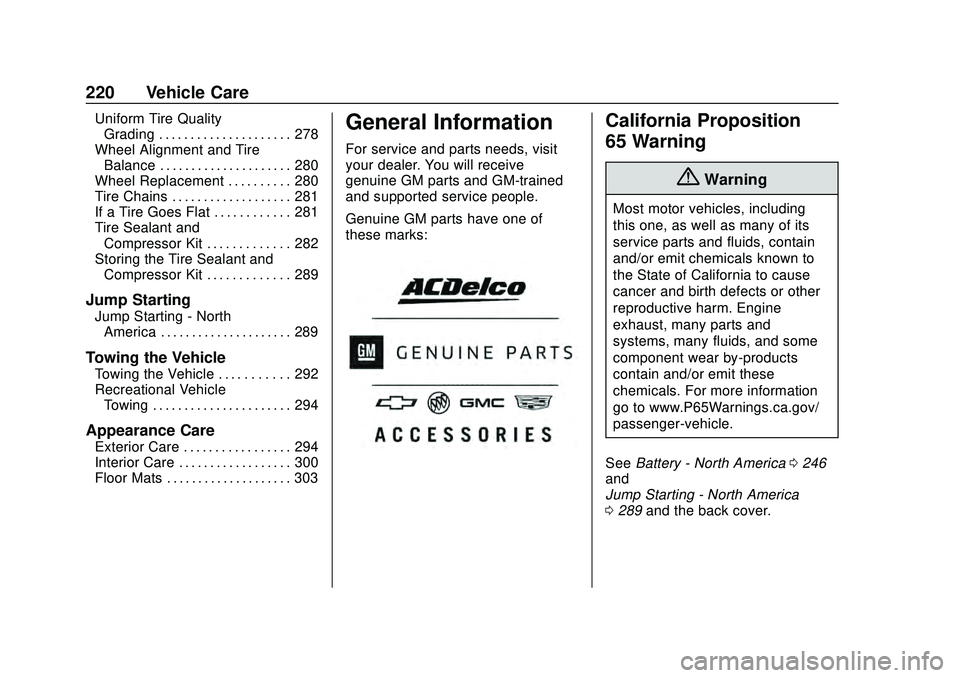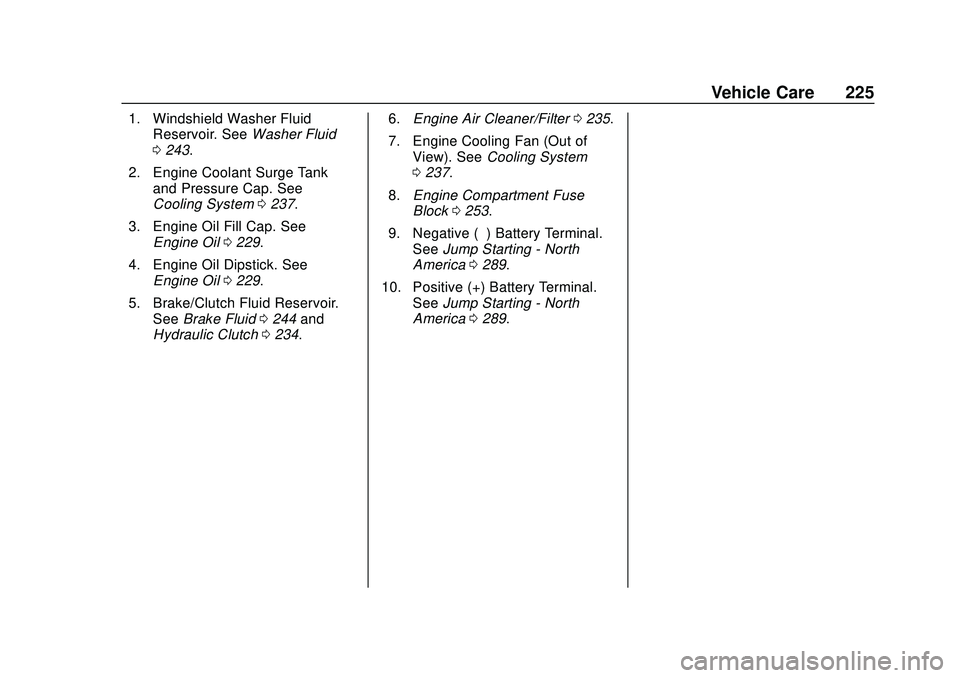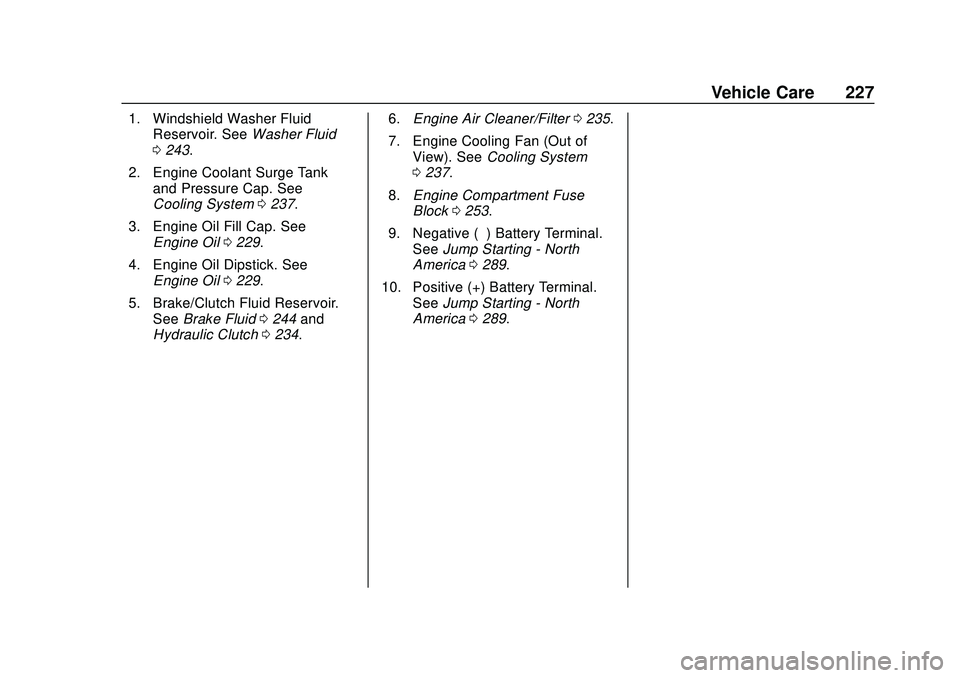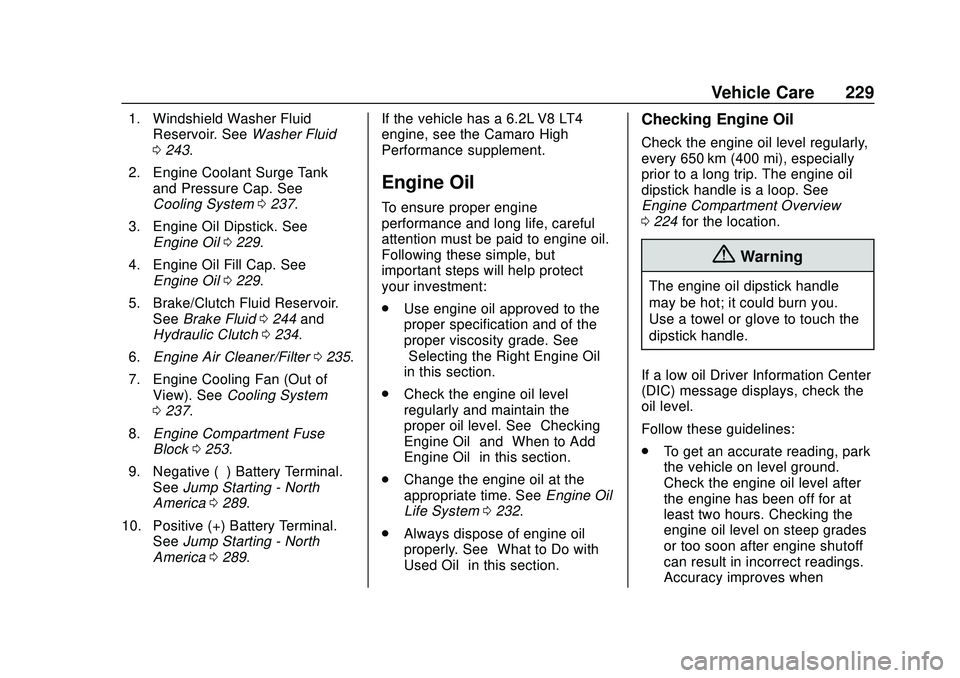CHEVROLET CAMARO 2020 Get To Know Guide
Manufacturer: CHEVROLET, Model Year: 2020, Model line: CAMARO, Model: CHEVROLET CAMARO 2020Pages: 361, PDF Size: 3.27 MB
Page 221 of 361

Chevrolet Camaro Owner Manual (GMNA-Localizing-U.S./Canada/Mexico-
13556304) - 2020 - CRC - 9/3/19
220 Vehicle Care
Uniform Tire QualityGrading . . . . . . . . . . . . . . . . . . . . . 278
Wheel Alignment and Tire Balance . . . . . . . . . . . . . . . . . . . . . 280
Wheel Replacement . . . . . . . . . . 280
Tire Chains . . . . . . . . . . . . . . . . . . . 281
If a Tire Goes Flat . . . . . . . . . . . . 281
Tire Sealant and
Compressor Kit . . . . . . . . . . . . . 282
Storing the Tire Sealant and Compressor Kit . . . . . . . . . . . . . 289
Jump Starting
Jump Starting - NorthAmerica . . . . . . . . . . . . . . . . . . . . . 289
Towing the Vehicle
Towing the Vehicle . . . . . . . . . . . 292
Recreational VehicleTowing . . . . . . . . . . . . . . . . . . . . . . 294
Appearance Care
Exterior Care . . . . . . . . . . . . . . . . . 294
Interior Care . . . . . . . . . . . . . . . . . . 300
Floor Mats . . . . . . . . . . . . . . . . . . . . 303
General Information
For service and parts needs, visit
your dealer. You will receive
genuine GM parts and GM-trained
and supported service people.
Genuine GM parts have one of
these marks:
California Proposition
65 Warning
{Warning
Most motor vehicles, including
this one, as well as many of its
service parts and fluids, contain
and/or emit chemicals known to
the State of California to cause
cancer and birth defects or other
reproductive harm. Engine
exhaust, many parts and
systems, many fluids, and some
component wear by-products
contain and/or emit these
chemicals. For more information
go to www.P65Warnings.ca.gov/
passenger-vehicle.
See Battery - North America 0246
and
Jump Starting - North America
0 289 and the back cover.
Page 222 of 361

Chevrolet Camaro Owner Manual (GMNA-Localizing-U.S./Canada/Mexico-
13556304) - 2020 - CRC - 9/3/19
Vehicle Care 221
California Perchlorate
Materials Requirements
Certain types of automotive
applications, such as airbag
initiators, seat belt pretensioners,
and lithium batteries contained in
electronic keys, may contain
perchlorate materials. Perchlorate
Material–special handling may
apply. See www.dtsc.ca.gov/
hazardouswaste/perchlorate.
Accessories and
Modifications
Adding non-dealer accessories or
making modifications to the vehicle
can affect vehicle performance and
safety, including such things as
airbags, braking, stability, ride and
handling, emissions systems,
aerodynamics, durability, and
electronic systems like antilock
brakes, traction control, and stability
control. These accessories or
modifications could even cause
malfunction or damage not covered
by the vehicle warranty. Damage to suspension components
caused by modifying vehicle height
outside of factory settings will not be
covered by the vehicle warranty.
Damage to vehicle components
resulting from modifications or the
installation or use of non-GM
certified parts, including control
module or software modifications, is
not covered under the terms of the
vehicle warranty and may affect
remaining warranty coverage for
affected parts.
GM Accessories are designed to
complement and function with other
systems on the vehicle. See your
dealer to accessorize the vehicle
using genuine GM Accessories
installed by a dealer technician.
Also, see
Adding Equipment to the
Airbag-Equipped Vehicle 068.
Vehicle Checks
Doing Your Own
Service Work
{Warning
It can be dangerous to work on
your vehicle if you do not have
the proper knowledge, service
manual, tools, or parts. Always
follow owner ’s manual procedures
and consult the service manual
for your vehicle before doing any
service work.
If doing some of your own service
work, use the proper service
manual. It tells you much more
about how to service the vehicle
than this manual can. To order the
proper service manual, see
Publication Ordering Information
0 333.
This vehicle has an airbag system.
Before attempting to do your own
service work, see Servicing the
Airbag-Equipped Vehicle 068.
Page 223 of 361

Chevrolet Camaro Owner Manual (GMNA-Localizing-U.S./Canada/Mexico-
13556304) - 2020 - CRC - 9/3/19
222 Vehicle Care
If equipped with remote vehicle
start, open the hood before
performing any service work to
prevent remote starting the vehicle
accidentally. SeeRemote Vehicle
Start 016.
Keep a record with all parts receipts
and list the mileage and the date of
any service work performed. See
Maintenance Records 0318.
Caution
Even small amounts of
contamination can cause damage
to vehicle systems. Do not allow
contaminants to contact the fluids,
reservoir caps, or dipsticks.
Hood
{Warning
Turn the vehicle off before
opening the hood. If the engine is
running with the hood open, you
or others could be injured.
{Warning
Components under the hood can
get hot from running the engine.
To help avoid the risk of burning
unprotected skin, never touch
these components until they have
cooled, and always use a glove or
towel to avoid direct skin contact.
Clear any snow from the hood
before opening.
To open the hood: 1. Pull the hood release lever with the
isymbol. It is on the
lower left side of the instrument
panel.
2. Go to the front of the vehicle and locate the secondary
release lever under the front
center of the hood. Push the
secondary hood release lever
to the right to release.
3. After you have partially lifted the hood, the gas strut system
will automatically lift the hood
and hold it in the fully open
position.
To close the hood: 1. Before closing the hood, be sure all filler caps are on
properly, and all tools are
removed.
Page 224 of 361

Chevrolet Camaro Owner Manual (GMNA-Localizing-U.S./Canada/Mexico-
13556304) - 2020 - CRC - 9/3/19
Vehicle Care 223
2. Pull the hood down until thestrut system is no longer
holding up the hood.
3. Allow the hood to fall. Check to make sure the hood is latched
completely. Repeat this
process with additional force if
necessary.
{Warning
Do not drive the vehicle if the
hood is not latched completely.
The hood could open fully, block
your vision, and cause a crash.
You or others could be injured.
Always close the hood completely
before driving.
Page 225 of 361

Chevrolet Camaro Owner Manual (GMNA-Localizing-U.S./Canada/Mexico-
13556304) - 2020 - CRC - 9/3/19
224 Vehicle Care
Engine Compartment Overview
2.0L L4 Engine (LTG)
Page 226 of 361

Chevrolet Camaro Owner Manual (GMNA-Localizing-U.S./Canada/Mexico-
13556304) - 2020 - CRC - 9/3/19
Vehicle Care 225
1. Windshield Washer FluidReservoir. See Washer Fluid
0 243.
2. Engine Coolant Surge Tank and Pressure Cap. See
Cooling System 0237.
3. Engine Oil Fill Cap. See Engine Oil 0229.
4. Engine Oil Dipstick. See Engine Oil 0229.
5. Brake/Clutch Fluid Reservoir. See Brake Fluid 0244 and
Hydraulic Clutch 0234. 6.
Engine Air Cleaner/Filter 0235.
7. Engine Cooling Fan (Out of View). See Cooling System
0 237.
8. Engine Compartment Fuse
Block 0253.
9. Negative (–) Battery Terminal. See Jump Starting - North
America 0289.
10. Positive (+) Battery Terminal. SeeJump Starting - North
America 0289.
Page 227 of 361

Chevrolet Camaro Owner Manual (GMNA-Localizing-U.S./Canada/Mexico-
13556304) - 2020 - CRC - 9/3/19
226 Vehicle Care
3.6L V6 Engine (LGX)
Page 228 of 361

Chevrolet Camaro Owner Manual (GMNA-Localizing-U.S./Canada/Mexico-
13556304) - 2020 - CRC - 9/3/19
Vehicle Care 227
1. Windshield Washer FluidReservoir. See Washer Fluid
0 243.
2. Engine Coolant Surge Tank and Pressure Cap. See
Cooling System 0237.
3. Engine Oil Fill Cap. See Engine Oil 0229.
4. Engine Oil Dipstick. See Engine Oil 0229.
5. Brake/Clutch Fluid Reservoir. See Brake Fluid 0244 and
Hydraulic Clutch 0234. 6.
Engine Air Cleaner/Filter 0235.
7. Engine Cooling Fan (Out of View). See Cooling System
0 237.
8. Engine Compartment Fuse
Block 0253.
9. Negative (–) Battery Terminal. See Jump Starting - North
America 0289.
10. Positive (+) Battery Terminal. SeeJump Starting - North
America 0289.
Page 229 of 361

Chevrolet Camaro Owner Manual (GMNA-Localizing-U.S./Canada/Mexico-
13556304) - 2020 - CRC - 9/3/19
228 Vehicle Care
6.2L V8 Engine (LT1)
Page 230 of 361

Chevrolet Camaro Owner Manual (GMNA-Localizing-U.S./Canada/Mexico-
13556304) - 2020 - CRC - 9/3/19
Vehicle Care 229
1. Windshield Washer FluidReservoir. See Washer Fluid
0 243.
2. Engine Coolant Surge Tank and Pressure Cap. See
Cooling System 0237.
3. Engine Oil Dipstick. See Engine Oil 0229.
4. Engine Oil Fill Cap. See Engine Oil 0229.
5. Brake/Clutch Fluid Reservoir. See Brake Fluid 0244 and
Hydraulic Clutch 0234.
6. Engine Air Cleaner/Filter 0235.
7. Engine Cooling Fan (Out of View). See Cooling System
0 237.
8. Engine Compartment Fuse
Block 0253.
9. Negative (–) Battery Terminal. See Jump Starting - North
America 0289.
10. Positive (+) Battery Terminal. SeeJump Starting - North
America 0289. If the vehicle has a 6.2L V8 LT4
engine, see the Camaro High
Performance supplement.
Engine Oil
To ensure proper engine
performance and long life, careful
attention must be paid to engine oil.
Following these simple, but
important steps will help protect
your investment:
.
Use engine oil approved to the
proper specification and of the
proper viscosity grade. See
“Selecting the Right Engine Oil”
in this section.
. Check the engine oil level
regularly and maintain the
proper oil level. See “Checking
Engine Oil” and“When to Add
Engine Oil” in this section.
. Change the engine oil at the
appropriate time. See Engine Oil
Life System 0232.
. Always dispose of engine oil
properly. See “What to Do with
Used Oil” in this section.
Checking Engine Oil
Check the engine oil level regularly,
every 650 km (400 mi), especially
prior to a long trip. The engine oil
dipstick handle is a loop. See
Engine Compartment Overview
0224 for the location.
{Warning
The engine oil dipstick handle
may be hot; it could burn you.
Use a towel or glove to touch the
dipstick handle.
If a low oil Driver Information Center
(DIC) message displays, check the
oil level.
Follow these guidelines:
. To get an accurate reading, park
the vehicle on level ground.
Check the engine oil level after
the engine has been off for at
least two hours. Checking the
engine oil level on steep grades
or too soon after engine shutoff
can result in incorrect readings.
Accuracy improves when